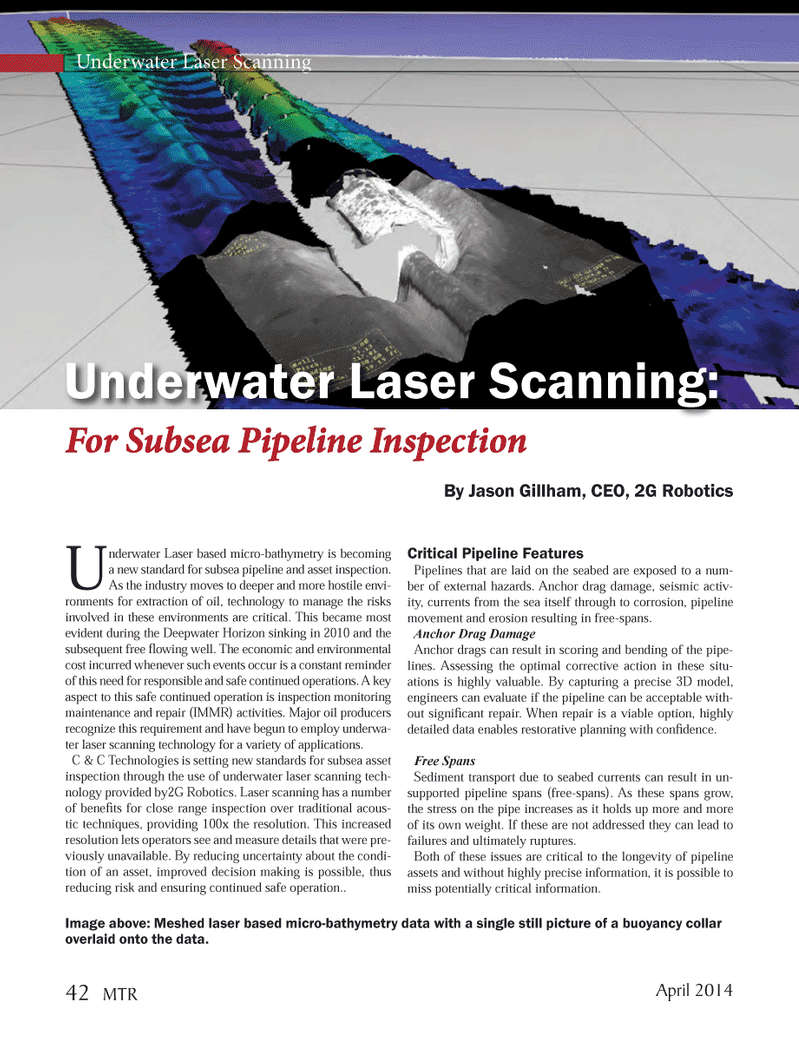
Page 42: of Marine Technology Magazine (April 2014)
Offshore Energy
Read this page in Pdf, Flash or Html5 edition of April 2014 Marine Technology Magazine
Underwater Laser Scanning
U nderwater Laser based micro-bathymetry is becoming a new standard for subsea pipeline and asset inspection.
As the industry moves to deeper and more hostile envi- ronments for extraction of oil, technology to manage the risks involved in these environments are critical. This became most evident during the Deepwater Horizon sinking in 2010 and the subsequent free fl owing well. The economic and environmental cost incurred whenever such events occur is a constant reminder of this need for responsible and safe continued operations. A key aspect to this safe continued operation is inspection monitoring maintenance and repair (IMMR) activities. Major oil producers recognize this requirement and have begun to employ underwa- ter laser scanning technology for a variety of applications.
C & C Technologies is setting new standards for subsea asset inspection through the use of underwater laser scanning tech- nology provided by2G Robotics. Laser scanning has a number of benefi ts for close range inspection over traditional acous- tic techniques, providing 100x the resolution. This increased resolution lets operators see and measure details that were pre- viously unavailable. By reducing uncertainty about the condi- tion of an asset, improved decision making is possible, thus reducing risk and ensuring continued safe operation..
Critical Pipeline Features
Pipelines that are laid on the seabed are exposed to a num- ber of external hazards. Anchor drag damage, seismic activ- ity, currents from the sea itself through to corrosion, pipeline movement and erosion resulting in free-spans.
Anchor Drag Damage
Anchor drags can result in scoring and bending of the pipe- lines. Assessing the optimal corrective action in these situ- ations is highly valuable. By capturing a precise 3D model, engineers can evaluate if the pipeline can be acceptable with- out signifi cant repair. When repair is a viable option, highly detailed data enables restorative planning with confi dence.
Free Spans
Sediment transport due to seabed currents can result in un- supported pipeline spans (free-spans). As these spans grow, the stress on the pipe increases as it holds up more and more of its own weight. If these are not addressed they can lead to failures and ultimately ruptures.
Both of these issues are critical to the longevity of pipeline assets and without highly precise information, it is possible to miss potentially critical information.
Underwater Laser Scanning:
For Subsea Pipeline Inspectionr Sub ea Pipeline I spec on
By Jason Gillham, CEO, 2G Robotics
Image above: Meshed laser based micro-bathymetry data with a single still picture of a buoyancy collar overlaid onto the data.
April 2014 42 MTR
MTR #3 (34-49).indd 42 4/9/2014 10:59:59 AM

 41
41

 43
43
